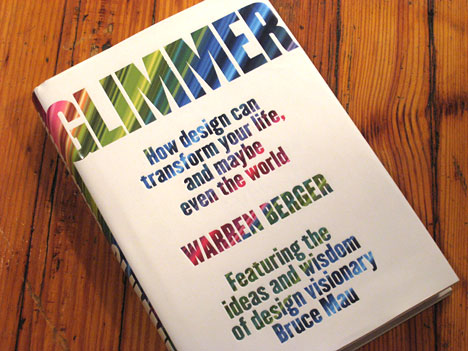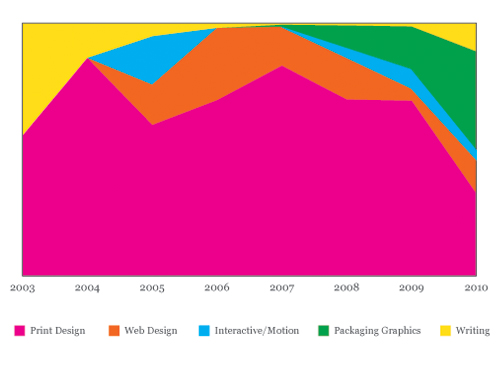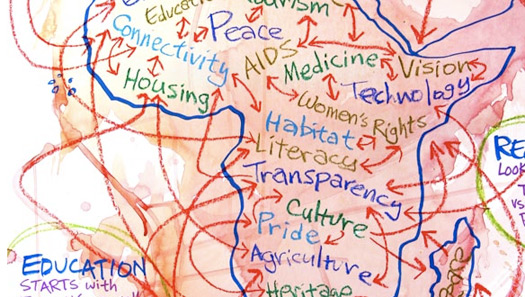The Four Phases of Design Thinking
According to Warren Berger, author of GLIMMER: How design can transform, business, your life, and maybe even the world, The four phases of design thinking are:
Question.
Care.
Connect.
Commit.
Read more about it via The Four Phases of Design Thinking — Warren Berger — The Conversation — Harvard Business Review.

Inspiration, Brainstorming and the Creative Process
This week I was just too tired to read or write much of anything. I only have three weeks left of work and each day seems to drag on slower than the last. I’m taking this opportunity to post links to some interesting articles and videos I have collected over the past few weeks, covering the topics of inspiration, brainstorming and the creative process. Read More
The Design Imperialism Debate
As soon as I wrote my post about Emily Pilloton’s Design Revolution Roadshow, my husband was quick to show me this article written by Bruce Nussbaum over at Fast Company: Is Humanitarian Design the New Imperialism?
This article has caused quite a stir in the design community. At first glance, I found the article to be overly critical and I didn’t like how Nussbaum lumped Emily Pilloton, Project H and every single humanitarian design effort together and labeled it as one big flawed movement. Admittedly, I was also a little annoyed with my husband for giving me such a buzz kill after I was all excited about Design Revolution and Project H’s work, but I decided to save the link to the article for later anyway.
Today I had time to revisit the article and read it more thoroughly. I also had the chance to look at several responses from other designers. This is when it became more interesting and post-worthy to me. Read More
A Map of My Work Life
 Since it has been a very slow day at work, I decided to kill some time by mapping out my work history just like Adam Richardson did in his post “Mapping My Work Life” on frog design’s design mind blog. His map is a lot more interesting than mine since it spans almost 20 years.I chose to start in 2003 since that is when I took my first Graphic Design class. It’s interesting to look back and think about how and when I started branching off into different areas like web design, interactivity and packaging graphics. Just like Adam Richardson, I had a spike in writing when I was in school, and it also escalated this past year when I was writing for admission into graduate school as well as starting this blog. I anticipate the time I spend writing to go way up next year!As I look into the future, I see myself adding a few new categories and I will probably see a complete drop off in some of the categories that currently take up the bulk of my time. I really think I might keep charting this as time goes by so I can have an interesting visual representation of my life’s work.
Since it has been a very slow day at work, I decided to kill some time by mapping out my work history just like Adam Richardson did in his post “Mapping My Work Life” on frog design’s design mind blog. His map is a lot more interesting than mine since it spans almost 20 years.I chose to start in 2003 since that is when I took my first Graphic Design class. It’s interesting to look back and think about how and when I started branching off into different areas like web design, interactivity and packaging graphics. Just like Adam Richardson, I had a spike in writing when I was in school, and it also escalated this past year when I was writing for admission into graduate school as well as starting this blog. I anticipate the time I spend writing to go way up next year!As I look into the future, I see myself adding a few new categories and I will probably see a complete drop off in some of the categories that currently take up the bulk of my time. I really think I might keep charting this as time goes by so I can have an interesting visual representation of my life’s work.
Design Revolution Roadshow: Changing the World by Design
Emily Pilloton is the Founder and Executive Director of Project H, a non-profit company she launched in January of 2008 at the age of 26. Pilloton decided to start the company after feeling as though her skills as a designer were misdirected. She wanted to become a change maker instead of a stuff creator.
What began as a tour for her book, “Design Revolution: 100 Products that Empower People,” ended up becoming much more. Pilloton used her 2009 Sappi Ideas that Matter Grant to turn the book tour into a mobile exhibition with workshops and lectures geared towards inspiring the next generation of young designers and promoting the idea that design can have a positive social impact. Read More

